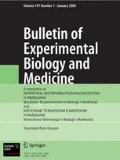2,6-Diisobornyl-4-methylphenol (Dibornol, 10 mg/kg intragastrically daily for 5 days after myocardial ischemia/reperfusion) 1.5-fold increased rat survival during the acute post-infarction period in comparison with the control group. In survivors, Dibornol reliably prevented post-ischemic progression of heart failure in the delayed post-infarction period (30 days after ischemia/reperfusion), which was seen from an increase in the left-ventricular developed pressure by 22%, left-ventricular contractility index by 19%, and +dP/dt by 34%. Left-ventricular end-diastolic pressure was by 39% lower than in control animals. Morphological study of heart sections from control group animals showed that Dibornol reduced the area of post-ischemic myocardial damage in the delayed period after ischemia/reperfusion to 3±1% (vs 18±2% in the control group).
Similar content being viewed by others
References
Plotnikov MB, Ivanov IS, Smolyakova VI, Chernisheva GA, Kuchin AV, Chukicheva IJ, Krasnov EA. Antioxidant activity of the o-isobornylphenol derivate in rats with cerebral ischemia. Vopr. Biol., Med. Farm. Khimii. 2010;(5):23-25. Russian.
Plotnikov MB, Smolyakova VI, Ivanov IS, Kuchin AV, Chukicheva IJ, Krasnov EA. Antithrombogenic and antiplatelet activity of optho-isobornyl phenol derivative. Bull. Exp. Biol. Med. 2008;145(3):328-330.
Plotnikova TM, Chernysheva GA, Smol’yakova VI, Shcheti-nin PP, Kuchin AV, Chukicheva IY, Plotnikov MB. Hemorheologic effects of Dibornol in a model of myocardial ischemia/reperfusion. Bull. Exp. Biol. Med. 2014;157(2):211-214. doi: https://doi.org/10.1007/s10517-014-2527-8
Plotnikova TM, Chernysheva GA, Smol’yakova VA, Shchetinin PP, Kuchin AV, Chukicheva IY, Plotnikov MB. Cardioprotective Activity of 2,6-Diisobornyl-4-Methylphenol in Acute Myocardial Ischemia/Reperfusion in Rats. Bull. Exp. Biol. Med. 2018;165(5):657-659. doi: https://doi.org/10.1007/s10517-018-4235-2
Chen H, Dong Y, He X, Li J, Wang J. Paeoniflorin improves cardiac function and decreases adverse postinfarction left ventricular remodeling in a rat model of acute myocardial infarction. Drug Des. Devel. Ther. 2018;12:823-836.
Fliss H, Gattinger D. Apoptosis in ischemic and reperfused rat myocardium. Circ. Res. 1996;79(5):949-956.
Hasenfuss G, Maier LS. Mechanism of action of the new anti-ischemia drug ranolazine. Clin. Res. Cardiol. 2008;97(4):222-226.
Kleikers PW, Wingler K, Hermans JJ, Diebold I, Altenhöfer S, Radermacher KA, Janssen B, Görlach A, Schmidt HH. NADPH oxidases as a source of oxidative stress and molecular target in ischemia/reperfusion injury. J. Mol. Med. (Berl). 2012;90(12):1391-1406.
Lichý M, Szobi A, Hrdlička J, Horváth C, Kormanová V, Rajtík T, Neckář J, Kolář F, Adameová A. Different signalling in infarcted and non-infarcted areas of rat failing hearts: A role of necroptosis and inflammation. J. Cell. Mol. Med. 2019;23(9):6429-6441.
Martindale JJ, Metzger JM. Uncoupling of increased cellular oxidative stress and myocardial ischemia reperfusion injury by directed sarcolemma stabilization. J. Mol. Cell. Cardiol. 2014;67:26-37.
Pasumarthi KB, Field LJ. Cardiomyocyte cell cycle regulation. Circ. Res. 2002;90(10):1044-1054.
Song CL, Liu B, Diao HY, Shi YF, Li YX, Zhang JC, Lu Y, Wang G, Liu J, Yu YP, Guo ZY, Wang JP, Zhao Z, Liu JG, Liu YH, Liu ZX, Cai D, Li Q. The protective effect of microRNA-320 on left ventricular remodeling after myocardial ischemia-reperfusion injury in the rat model. Int. J. Mol. Sci. 2014;15(10):17,442-17,456.
Turer AT, Hill JA. Pathogenesis of myocardial ischemia-reperfusion injury and rationale for therapy. Am. J. Cardiol. 2010;106(3):360-368.
Author information
Authors and Affiliations
Corresponding author
Additional information
Translated from Byulleten’ Eksperimental’noi Biologii i Meditsiny, Vol. 169, No. 3, pp. 366-371, March, 2020
Rights and permissions
About this article
Cite this article
Chernysheva, G.A., Smol’yakova, V.I., Kutchin, A.V. et al. 2,6-Diisobornyl-4-Methylphenol Reduces Postishemic Myocardium Remodeling in Delayed Period after Ischemia/Reperfusion in Rats. Bull Exp Biol Med 169, 310–313 (2020). https://doi.org/10.1007/s10517-020-04876-9
Received:
Published:
Issue Date:
DOI: https://doi.org/10.1007/s10517-020-04876-9


